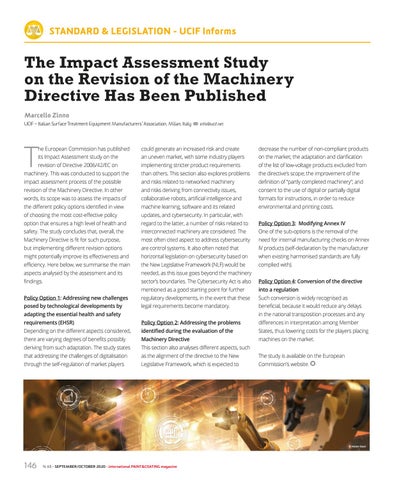STANDARD & LEGISLATION - UCIF Informs
The Impact Assessment Study on the Revision of the Machinery Directive Has Been Published Marcello Zinno UCIF – Italian Surface Treatment Equipment Manufacturers’ Association, Milan, Italy
T
info@ucif.net
he European Commission has published
could generate an increased risk and create
decrease the number of non-compliant products
its Impact Assessment study on the
an uneven market, with some industry players
on the market; the adaptation and clarification
revision of Directive 2006/42/EC on
implementing stricter product requirements
of the list of low-voltage products excluded from
machinery. This was conducted to support the
than others. This section also explores problems
the directive’s scope; the improvement of the
impact assessment process of the possible
and risks related to networked machinery
definition of “partly completed machinery”; and
revision of the Machinery Directive. In other
and risks deriving from connectivity issues,
consent to the use of digital or partially digital
words, its scope was to assess the impacts of
collaborative robots, artificial intelligence and
formats for instructions, in order to reduce
the different policy options identified in view
machine learning, software and its related
environmental and printing costs.
of choosing the most cost-effective policy
updates, and cybersecurity. In particular, with
option that ensures a high level of health and
regard to the latter, a number of risks related to
Policy Option 3: Modifying Annex IV
safety. The study concludes that, overall, the
interconnected machinery are considered. The
One of the sub-options is the removal of the
Machinery Directive is fit for such purpose,
most often cited aspect to address cybersecurity
need for internal manufacturing checks on Annex
but implementing different revision options
are control systems. It also often noted that
IV products (self-declaration by the manufacturer
might potentially improve its effectiveness and
horizontal legislation on cybersecurity based on
when existing harmonised standards are fully
efficiency. Here below, we summarise the main
the New Legislative Framework (NLF) would be
complied with).
aspects analysed by the assessment and its
needed, as this issue goes beyond the machinery
findings.
sector’s boundaries. The Cybersecurity Act is also
Policy Option 4: Conversion of the directive
mentioned as a good starting point for further
into a regulation
Policy Option 1: Addressing new challenges
regulatory developments, in the event that these
Such conversion is widely recognised as
posed by technological developments by
legal requirements become mandatory.
beneficial, because it would reduce any delays in the national transposition processes and any
adapting the essential health and safety requirements (EHSR)
Policy Option 2: Addressing the problems
differences in interpretation among Member
Depending on the different aspects considered,
identified during the evaluation of the
States, thus lowering costs for the players placing
there are varying degrees of benefits possibly
Machinery Directive
machines on the market.
deriving from such adaptation. The study states
This section also analyses different aspects, such
that addressing the challenges of digitalisation
as the alignment of the directive to the New
The study is available on the European
through the self-regulation of market players
Legislative Framework, which is expected to
Commission’s website.
© Adobe Stock
146
N. 65 - SEPTEMBER/OCTOBER 2020 - international PAINT&COATING magazine
